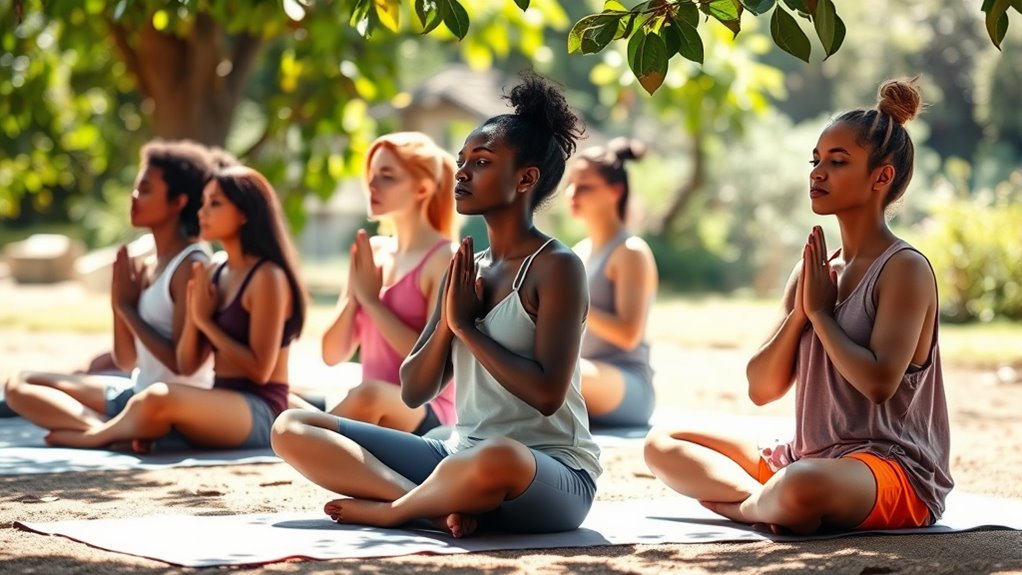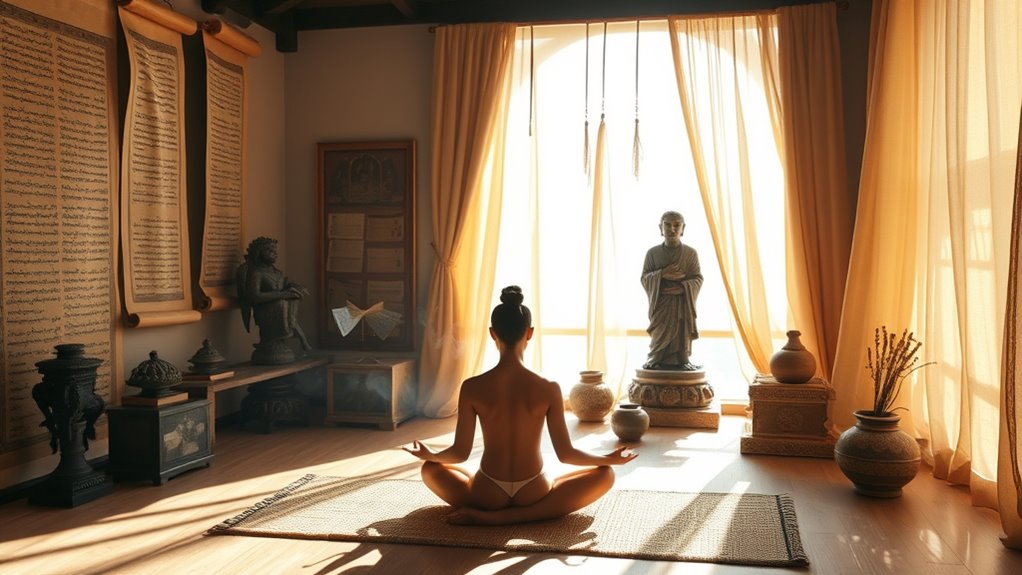The art of breathing involves more than just your body’s basic functions; it’s a powerful tool for enhancing health and well-being. By practicing techniques like diaphragmatic breathing, you can lower stress, improve heart function, and boost emotional balance. Controlled breathing helps manage anxiety and sharpen focus, while integrating these methods into your daily routine can create lasting benefits. Discover how to unlock the full potential of your breath for a healthier, more centered life.
Key Takeaways
- Breathing techniques, such as diaphragmatic and box breathing, enhance relaxation, reduce stress, and promote emotional regulation.
- Controlled breathing can lower blood pressure and improve cardiovascular health through enhanced oxygen intake and lung capacity.
- Mindfulness practices incorporating breathwork sharpen focus, cognitive functions, and overall mental clarity.
- Historical traditions like pranayama and qigong emphasize breath control for spiritual and physical well-being.
- Integrating breathing exercises into daily routines fosters a deeper connection between body and mind, enhancing overall resilience.
The Science Behind Breathing Techniques

Breathing techniques are grounded in a fascinating interplay of physiological mechanisms that regulate how we breathe. Your respiratory center constantly adjusts your breathing rate and depth based on levels of carbon dioxide and oxygen in your blood. Chemoreceptors in your arteries play a crucial role, detecting metabolic changes to fine-tune ventilation. While your breathing operates reflexively, you can also exert voluntary control, especially when speaking or playing an instrument. This dual regulation allows your brain to adapt your patterns based on feedback from your body. Moreover, your emotional state can influence these patterns, as stress often leads to faster breathing, while slow, controlled breathing can activate a relaxation response, promoting well-being and emotional balance. Additionally, controlled breathing can significantly lower blood pressure, enhancing overall cardiovascular health. Furthermore, integrating juice cleanses into your routine can provide a concentrated source of vitamins and antioxidants that support overall wellness. For instance, the nutritional advantages of green juice can enhance your immune health and promote detoxification. Moreover, drinking celery juice during pregnancy can be beneficial due to its high folate content, which is important for fetal development. Furthermore, incorporating high fiber foods like chia seeds into your diet can support digestive health, which is linked to improved overall wellness and may complement the benefits of breathing techniques. It is essential to remember that hydration plays a vital role in maintaining optimal respiratory function and overall health.
Exploring Different Breathing Methods

How can you harness the power of different breathing methods to enhance your well-being? Each technique offers unique benefits.
Diaphragmatic breathing strengthens your diaphragm, promoting deep relaxation. Research shows that breast cancer awareness can also benefit from practices that reduce stress and anxiety, which are crucial for overall health. Additionally, advancements in natural language processing allow for better integration of health-related technologies that can support mental well-being. Incorporating nighttime meditation alongside these breathing techniques can further enhance relaxation and improve sleep quality. Pursed lip breathing slows your breath, which is especially helpful for managing COPD. Deep breathing expands your lungs and aids recovery after surgery, contributing to enhanced respiratory function. Regular practice of these techniques can be as vital as ensuring access to portable camping toilets for comfort during outdoor activities. Furthermore, ensuring your emotional needs are met, as seen in health and wellness considerations, can greatly enhance the effectiveness of these breathing methods.
The Active Cycle of Breathing Techniques clears pulmonary secretions and boosts lung function. Box breathing, with its rhythmic pattern, helps manage stress effectively.
You can incorporate these techniques into mindfulness practices to increase mental clarity and calmness. By learning and practicing these methods regularly, you’ll find they fit seamlessly into daily activities, enhancing your overall health and resilience.
Physiological Benefits of Controlled Breathing

Controlled breathing techniques offer numerous physiological benefits that can significantly enhance your overall health.
For instance, practicing slow and deep diaphragmatic breathing helps lower blood pressure and reduces your heart rate, promoting cardiovascular stability. You’ll also notice improved heart rate variability, a key marker of heart health. Additionally, regular physical activity, such as exercise for cardiovascular health, complements these breathing techniques to further enhance heart function. Incorporating energy-efficient systems into your lifestyle can also support cardiovascular health by promoting overall well-being. Maintaining a clean home environment can also contribute to enhanced mental well-being by reducing stress and anxiety levels, which further supports heart health. Furthermore, engaging in mindfulness practices can enhance the benefits of these breathing techniques by fostering a greater sense of calm and focus. Research suggests that these practices align with the Law of Attraction principles, enhancing emotional well-being.
Moreover, these techniques increase lung capacity and enhance oxygen intake, making your respiratory system more efficient. Regular breathing exercises can relieve muscle tension, improve posture, and boost physical energy by ensuring better oxygen delivery. Additionally, enhanced immune response may result from these practices as they lower stress hormones and reduce inflammation, ultimately supporting your body’s defense mechanisms.
Controlled breathing enhances lung capacity, improves oxygen intake, alleviates muscle tension, and boosts energy levels through better oxygen delivery.
Incorporate these practices into your daily routine for optimal health benefits.
Psychological Advantages of Breathing Exercises

Practicing controlled breathing not only benefits your body but also offers significant psychological advantages. Deep breathing exercises can help reduce stress and anxiety by lowering sympathetic activity and enhancing calm responses. You’ll find that these techniques support emotional regulation, leading to a more stable mental state. Moreover, breathwork can boost your mood more effectively than some mindfulness practices, fostering positive emotions and improving emotional wellbeing. As you become more aware of your emotions through breathing, you’ll enhance your resilience against challenges. Regular practice can also sharpen your cognitive functions, improving focus, decision-making, and creativity. By connecting with your breath, you create a powerful tool for mental clarity and emotional balance. Additionally, deep breathing has been shown to regulate the nervous system, facilitating relaxation responses that further contribute to emotional stability. This practice can also promote personalized learning pathways that enhance one’s understanding of emotional responses and coping mechanisms. Furthermore, studies suggest that astrological signs may influence perceived beauty, emphasizing the importance of self-image in emotional health. Interestingly, the act of integrating dream interpretation can further deepen your understanding of emotional responses, as dreams often reveal underlying feelings and conflicts. Understanding production quantity variance can also help you manage stress by encouraging a focus on achievable goals and expectations. Importantly, incorporating visualization techniques can enhance the effectiveness of your breathing exercises, allowing you to manifest desired emotional states more readily.
Therapeutic Uses of Breathing for Health

When you embrace breathing techniques, you unlock a range of therapeutic benefits for your health. Deep breathing can lower blood pressure and help manage pain by promoting relaxation. By improving oxygenation, these techniques send more oxygen to your organs, enhancing overall well-being. Mindfulness practices, such as deep breathing exercises, can further promote relaxation and focus during your breathing sessions. You’ll find that regular practice can enhance your immune system, helping to detoxify your body. Techniques like 4-7-8 breathing and diaphragmatic breathing can effectively reduce stress and anxiety. Additionally, using humor in communication, such as seniors texting humor, can also help alleviate feelings of isolation and contribute to mental well-being. Engaging in regular breathing exercises can amplify the benefits of renewable energy solutions, promoting a holistic approach to health and wellness. These practices also positively influence your autonomic nervous system, improving heart rate variability and cardiovascular health. Additionally, deep breathing promotes several positive responses within the body, making it a powerful tool for maintaining health and wellness. Whether you’re managing asthma or recovering from a stroke, incorporating breathing exercises into your routine can significantly boost your quality of life and long-term health.
Cultural Significance of Breathing Practices

Breathing practices have held profound cultural significance across various civilizations, serving not just as a means of sustenance but as a pathway to wellness, spirituality, and community connection.
In ancient India, pranayama is vital to yoga and Ayurveda, focusing on life energy control. Taoist traditions in China emphasize breath control through qigong and tai chi for wellness. Aristotle linked breathing to well-being, while Egyptian rituals used breath for spiritual purposes. Breathwork spans thousands of years, illustrating how diverse cultures have recognized its importance for holistic health and transformation.
In shamanic societies across continents, breath practices support healing and growth. Today, mindfulness and stress relief techniques have made breathwork central to modern wellness, fostering community and holistic health.
This rich tapestry of practices illustrates how breathing transcends mere survival to become a profound cultural cornerstone. Across various traditions, the act of breathing is woven into rituals, art forms, and daily practices, highlighting its central role in fostering connection and mindfulness. For instance, in the serene atmosphere of chic fincas in Menorca, visitors often engage in yoga sessions that emphasize breathwork, deepening their appreciation for both nature and the art of living fully in the moment. Through these mindful practices, breathing emerges as a vital thread that binds communities together, nurturing both individuality and a shared sense of belonging.
Historical Perspectives on Breathwork

Throughout history, various cultures have harnessed breathwork as a vital tool for health, spirituality, and community.
In ancient India, pranayama emerged over 5,000 years ago, emphasizing breath control to regulate life energy. Meanwhile, Taoist traditions in China, like Qigong and Tai Chi, promoted well-being through breathwork.
Shamanic societies employed breath techniques for spiritual awakening and healing, while Buddhist practices focused on breath to achieve higher consciousness. Ayurveda also linked breathwork to health and balance. Breathwork methods have evolved over time, influenced by ancient practices and modern psychological research, further enriching its role in various healing traditions.
Techniques like alternate nostril breathing and vase breathing have been used for mind stabilization. Each culture contributed uniquely, weaving breathwork into their spiritual and healing practices, showing you just how important breathing has been throughout human history.
Integrating Breathing Techniques Into Daily Life

Many ancient cultures understood the transformative power of breathwork, and today, you can harness this wisdom to enhance your daily life. By integrating simple breathing techniques, you can reduce stress and anxiety while boosting focus and productivity.
Start your day with diaphragmatic breathing to set a positive tone, and use reminders throughout the day for quick breathing breaks. Techniques like box breathing and 4-7-8 breathing can help you unwind before bed. Engaging in conscious breathing allows you to connect deeply with your body and mind.
Tailor your routine to meet your personal needs—whether it’s stress relief or an energy boost. By combining breathwork with mindfulness, you’ll improve mental clarity and emotional regulation, ultimately enriching your overall well-being.
Make these practices a consistent part of your life for lasting benefits.
Frequently Asked Questions
Can Breathing Techniques Help With Athletic Performance?
Absolutely, breathing techniques can significantly enhance your athletic performance.
By improving respiratory muscle strength and endurance, you can increase your exercise capacity. Techniques like nasal breathing boost blood flow, while controlled breathing helps maintain focus during workouts.
Incorporating methods like box breathing aids in recovery, allowing you to perform better over time.
With consistent practice, you’ll notice improvements in both your physical endurance and mental concentration during your activities.
Are There Any Risks Associated With Breathing Exercises?
Yes, there are risks associated with breathing exercises. You might experience dizziness, tingling in your extremities, or even muscle spasms due to changes in oxygen levels.
If you have heart conditions or a history of seizures, it’s crucial to consult a healthcare professional before starting. Additionally, during pregnancy or with certain respiratory issues, you should proceed with caution.
Always prioritize your safety and listen to your body when practicing these techniques.
How Long Should I Practice Breathing Techniques Daily?
You might feel overwhelmed with stress one moment, then find calmness in the next.
To harness this, practicing breathing techniques daily for 5 to 10 minutes can be transformative. If you’re a beginner, start with just 2 to 5 minutes, gradually extending your sessions.
Consistency is key; try to practice several times a day for the best results. You’ll soon notice improvements in your mood and overall well-being by embracing this simple routine.
Can Children Benefit From Breathing Exercises?
Absolutely, children can benefit from breathing exercises!
They help reduce stress and improve emotional regulation, making it easier for kids to handle overwhelming feelings.
Plus, regular practice enhances focus and concentration, which can boost academic performance.
Breathing exercises also support physical health by improving oxygen delivery and reducing muscle tension.
What Is the Best Time of Day to Practice Breathing Techniques?
You’ll feel like a superhero when you practice breathing techniques at any time of day!
Mornings are great for a fresh start, while midday sessions can re-energize you and combat fatigue.
In the evening, deep breathing helps you unwind and prepares you for restful sleep.
Ultimately, the best time to practice is when you need it most—so tune in to your body, and breathe your way to balance and clarity whenever it suits you!
Conclusion
Incorporating breathing techniques into your daily routine can transform your well-being, like a gentle breeze refreshing a stifling summer day. By understanding the science and benefits behind controlled breathing, you not only enhance your physical health but also nurture your mental clarity. Whether you’re seeking calm amidst chaos or simply want to breathe better, embracing these practices is a step toward a more vibrant life. So, take a deep breath and savor the journey ahead!









